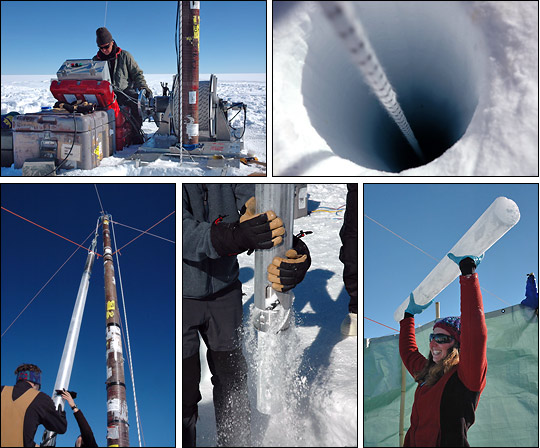
By drilling into the Antarctic Ice sheet and extracting core samples we are in effect going back in time. The physical properties of the ice and of material trapped in it can be used to reconstruct the climate over the age range of the core. The proportions of different oxygen and hydrogen isotopes provide information about ancient temperatures, and the air trapped in tiny bubbles can be analysed to determine the level of atmospheric gases such as carbon dioxide.
How Far back can we go?
Until now, the furtherest back we could go was 800,000 years.
The 800,000 year range enables charts such as the following to be constructed that show the precise levels of CO2 within our atmosphere over that time span …

Within the big-picture context, we can clearly see that our CO2 emissions are not normal.
Side Note: Are you wondering why there are natural pulses of CO2 emissions? The answer to that is orbital variations. Google the term “Milankovitch cycles“, and you can read all about it. Basically, other bodies within the solar system exert a gravitational pull that alters the orbit of earth in regular cycles. That bumps us in and out of ice ages in regular pulses, hence alters the amount of CO2 within our atmosphere as that happens.
What we have done with our CO2 emissions is to push our entire climate system out of that pattern.
New Ice Core Data – Going back 2 million years

New data has become available via a new Ice core sample that goes back 2 million years.
Published in Nature on 30th Oct under the title “Two-million-year-old snapshots of atmospheric gases from Antarctic ice“, it reveals the new insights granted via the availability of this new data.
Here we report the recovery of stratigraphically discontinuous ice more than two million years old from the Allan Hills Blue Ice Area, East Antarctica. Concentrations of carbon dioxide and methane in ice core samples older than two million years have been altered by respiration, but some younger samples are pristine. The recovered ice cores extend direct observations of atmospheric carbon dioxide, methane, and Antarctic temperature
What do we learn from this?
- Levels of CO2 and Climate are clearly linked in the 800k record – this new data sample shows that within the earlier time record going back 2 million years this correlation is maintained
- We also get new insights into past ice ages
What did we already know about past ice ages before this?
We knew that during the past one million years the cycle of ice ages followed by warm periods occurred every 100,000 years. But between 2.8 million years ago and 1.2 million years ago, those cycles were shorter, about 40,000 years, and ice ages were less extreme.
What do we now know from this data?
Carbon dioxide is linked to temperature in this earlier time period
“That’s an important baseline for understanding climate science and calibrating models that predict future change,” Brook said.
Where did the ice cores come from?
The ice core with the 2 million-year-old ice comes from an area known as Allan Hills, which is about 130 miles from the U.S. Antarctic research station known as McMurdo Station. Ancient meteorites had been found on the surface in this area, leading scientists to believe there could be ancient ice in the ice sheet.
The core with the 2 million-year-old ice was drilled to a depth of 200 meters during the 2015-16 field season. It takes one to two weeks to drill and recover a core like that, and several cores were collected in the region.
What comes next?
The research team is on its way back to Allan Hills in the coming days for two months of additional work. They will be collecting larger quantities of the 2 million year old ice and searching for even older samples.
“We don’t know the age limit in this area,” Brook said “It could be much older in some places. That’s why we’re going back. Pushing beyond two million years would be pretty amazing.”
I’ve Not read the book, can I see the Movie?
Of course. Here you go …
Further Reading
- Wikipedia Page on Ice Code data
- Wikipedia page on Milankovitch cycles
- Paper on new data: Nature (30th Oct 2019) – Two-million-year-old snapshots of atmospheric gases from Antarctic ice (they have a pay wall)
- Press Release – Oregon State University – Two million-year-old ice provides snapshot of Earth’s greenhouse gas history
